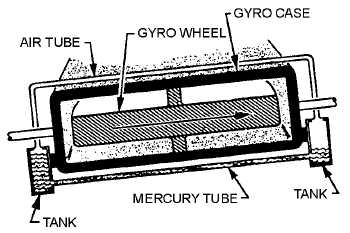3-15
Figure 3-12.—Mercury erecting system.
To overcome this difficulty, the point where the torque is applied must be moved. The torque point is
moved by causing the gimbal assembly to slowly and continuously rotate in the proper direction. This is
done in the following manner. With a small mercury tube, the mercury will take nearly a second to find
its level. At the same time the mercury is flowing, a small motor is rotating the gimbal supporting the
gyro about 18 times a minute. Therefore, during the time that it takes the mercury to flow into the low
tank, the entire gimbal assembly has rotated 90º. The torque will now be applied at a point which causes
the gyro to precess in the proper direction to maintain the gyro spin axis in a vertical position.
Mercury Ballistic Erecting System
The erection system used in many horizontal gyros is very similar to the vertical gyro system just
discussed. It is called the mercury ballistic erection system. The mercury ballistic system has the added
feature of maintaining the spin axis not only in the horizontal plane, but also with the spin axis aligned
North-South.
There are many different methods of causing free gyros to precess to either the vertical or the
horizontal plane. All such systems use the forces of gravity to sense variation from the desired position:
all systems also use the principles of precession to position the gyro property.
Q-16. What is the purpose of an erection system used with a gyro?
Q-17. What is the purpose of rotating the gimbal assembly in a gyro using a mercury erection system?
RATE GYROS
RATE GYROS are used in weapons control equipment, aircraft instrumentation, inertial navigation,
and in many other applications to detect and measure angular rates of change.
A rate gyro (sometimes called a rate-of-turn gyro) consists of a spinning rotor mounted in a single
gimbal, as shown in figure 3-13. A gyro mounted in this manner has one degree of freedom; that is, it is
free to tilt in only one direction. The rotor in a rate gyro is restrained from precessing by some means,
usually a spring arrangement. This is done to limit precession and to return the rotor to a neutral position
when there is no angular change taking place. Remember, the amount of precession of a gyro is
proportional to the force that causes the precession.

